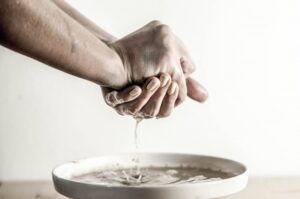What should I do if it is difficult to remove the plaster mold from the casting mold?

Hello, this is Fuchino.
What to do if you’ve poured plasma into a plaster mold during the casting process, and it won’t come off even after you’ve left it long enough to demold it!
What to do if it doesn’t come off even after a long time until demolding!
There are three main reasons why it is difficult to remove from a plaster mold.
1. too much agglutinant such as sodium silicate
2. The plaster mold is too wet.
3. Using a freshly made plaster mold.
The following is an explanation of how to deal with each of these problems.
1. When there is too much agglutinant such as sodium silicate
The reason for adding too much sodium silicate is that you want to reduce the viscosity of the clay and make it as smooth as possible, but it is difficult to do so.
The amount of sodium silicate used depends on the type of porcelain clay.
If the plasma does not become smooth, please increase the amount of water as well as sodium silicate. The second half of the previous article, “How to make casting plasma with porcelain clay? is a good reference. By increasing both the sodium silicate and water in stages, you will be able to make a silky plasma that will come off the plaster mold properly.
However, the more water you add, the longer it will take to remove it from the plaster mold.
If you really want to get it out of the plaster mold as quickly as possible, you can do so by deliberately increasing the viscosity of the plasma and casting in a slushy plasma if the shape of the object is filled, such as a mug handle. This method is not suitable for objects such as vases and teapots that need to be drained cleanly.
Even if plasma can be properly removed from a plaster mold, it will take longer to remove if the viscosity of the plasma is low, and it will remove more quickly if the viscosity of the plasma is high. The more silky the plasma is, the longer it takes to remove.
The amount of time it takes to remove the plaster depends on the condition of the plasma, but if the plasma is properly adjusted, it will come off properly.
Be careful not to add too much agglutinant, such as sodium silicate.
If too much sodium silicate has been added, add porcelain clay and water to the overfilled plasma to readjust it. You will have to readjust without adding sodium silicate.
2. If the plaster mold is too wet
Plaster molds lose their ability to absorb water when the same one is used repeatedly and continuously.
It will take longer for the third one to come off than the first one, and even longer for the tenth one to come off than the third one.
Plaster molds that have been used one day should be dried thoroughly before the next use. Alternatively, you can prepare several plaster molds and use them less frequently to reduce the amount of water absorbed by each mold, so that the mold will be closer to dry in a shorter drying time.
A plaster mold that has absorbed a lot of water will not come off. Let wet plaster molds dry.
3. In the case of a freshly made plaster mold
Freshly made plaster molds may contain potash soap residue.
Potassium soap, used as a mold release agent in the plaster mold making process, prevents the mold from releasing when cast.
In the case of freshly made plaster molds, the potassium soap can be removed by casting several times before production. Alternatively, potassium soap can be removed by wiping the area of the plaster mold where the plasma will be poured with a neutralizing agent or acetic acid solution.
Also, as with item #2, freshly made plaster molds contain a lot of water before they are dried. Dry it thoroughly before use.
When it is difficult to remove the plaster mold from the casting mold
What did you think?
If you are a potter with a similar problem, please refer to No. 1 to No. 3 and give it a try.
I wish I didn’t have to spend so much time worrying about these things and could spend more time making my work.
